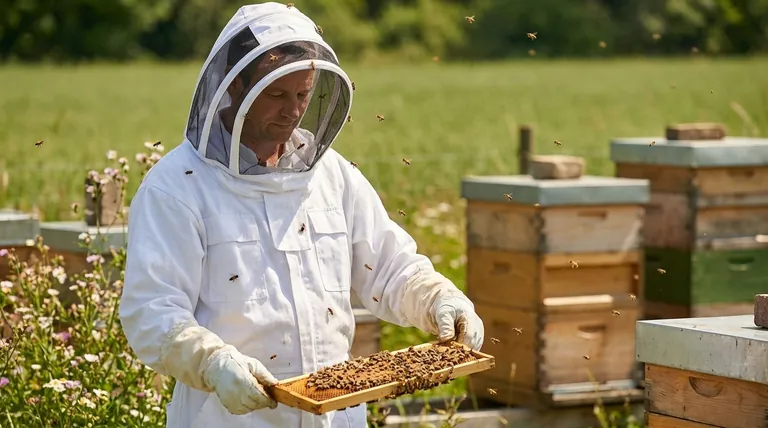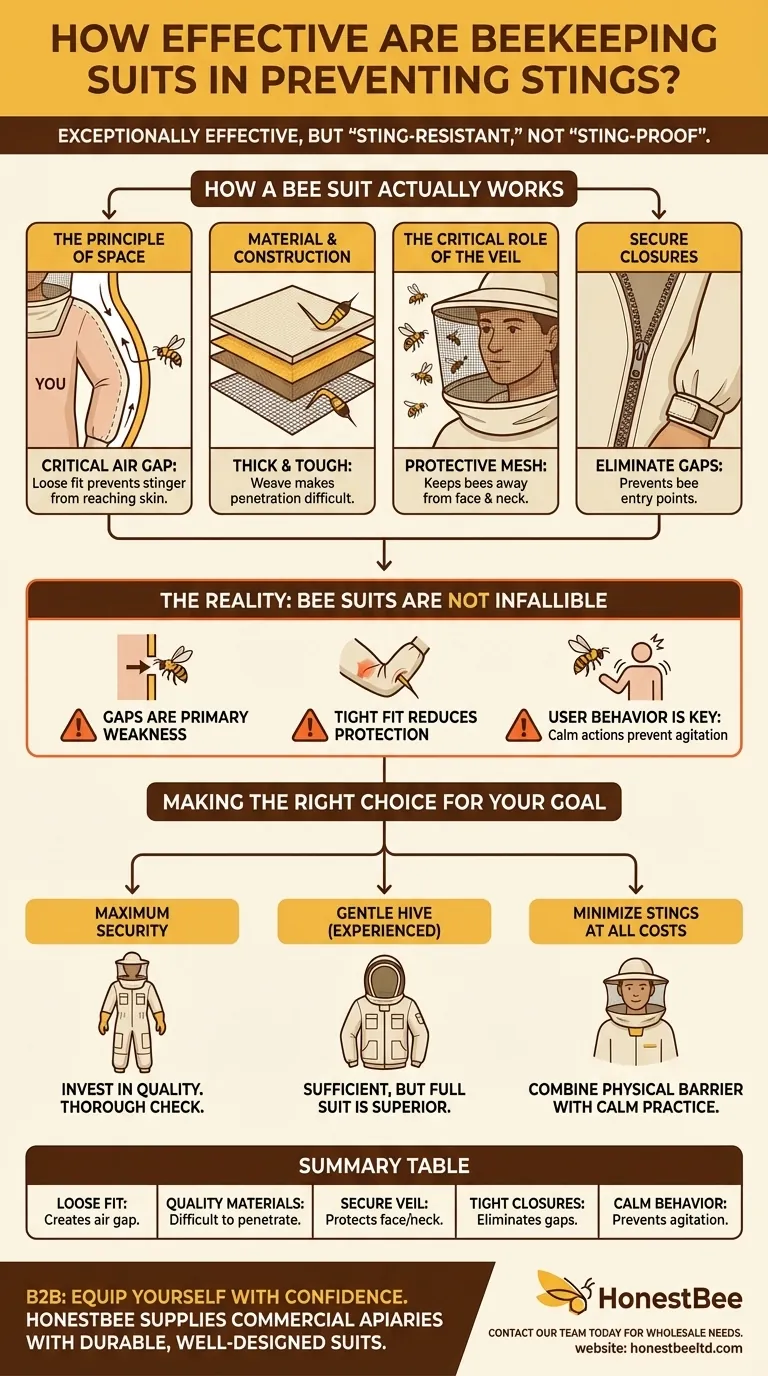Beekeeping suits are exceptionally effective at preventing stings, serving as the primary and most reliable barrier between you and the bees. A high-quality suit, when worn correctly, is the single best tool to significantly reduce your chances of being stung not only by honey bees, but also by wasps and hornets.
The core principle to understand is that bee suits are designed to be "sting-resistant," not entirely "sting-proof." Their effectiveness hinges on a combination of material, proper fit, and the user's own calm and deliberate actions.

How a Bee Suit Actually Works
A common misconception is that bee suits work like armor, simply being too tough for a stinger to penetrate. The actual mechanism is more nuanced, relying on several key principles to provide protection.
The Principle of Space
The most critical factor is the space the suit creates between the fabric and your skin. A bee's stinger is relatively short. A loose-fitting suit ensures that even if a bee attempts to sting the material, its stinger cannot reach your body.
Material and Construction
Modern bee suits are often made from thick cotton, nylon, or specialized ventilated fabrics. The weave and thickness of these materials make it difficult for a stinger to gain purchase and penetrate effectively.
The Critical Role of the Veil
The veil is arguably the most important component. It provides a strong, reinforced mesh that keeps bees away from the sensitive areas of your face and neck while maintaining visibility.
Secure Closures
High-quality suits feature overlapping zippers, elastic cuffs at the wrists and ankles, and often Velcro closures. These are designed to eliminate the gaps that a determined bee might otherwise exploit to get inside your suit.
The Reality: Bee Suits Are Not Infallible
Understanding the limitations of a bee suit is just as important as trusting its strengths. Acknowledging these realities allows you to use the equipment more effectively and safely.
Gaps Are the Primary Weakness
Even with the best design, a suit is only as good as how you wear it. The most common cause of stings while wearing a suit is a small gap left unsealed, typically between gloves and sleeves or boots and ankle cuffs.
A Tight Fit Reduces Protection
If the suit is pulled taut against your skin—for example, when bending over or stretching—it eliminates the protective air gap. In these tight spots, a bee can successfully sting through the fabric.
User Behavior is a Key Factor
A bee suit provides physical protection, but it doesn't prevent bees from becoming agitated. Moving calmly and deliberately is crucial. Quick, jerky movements or crushing a bee can release alarm pheromones, escalating the defensive response from the entire colony.
Making the Right Choice for Your Goal
Your approach to protective gear should align with your comfort level and the temperament of your hives.
- If your primary focus is maximum security and peace of mind: Invest in a full, high-quality ventilated suit and always perform a thorough check for gaps at the wrists, ankles, and neck before approaching a hive.
- If you are an experienced beekeeper working with a known gentle hive: A simple jacket and veil combination may feel sufficient, but remember that a full suit always offers superior protection against unexpected events.
- If your goal is to minimize stings at all costs: Combine the physical barrier of a properly worn suit with the behavioral practice of being a calm, respectful, and observant beekeeper.
Ultimately, a quality bee suit is an indispensable tool that empowers you to work confidently and safely with your bees.
Summary Table:
| Key Factor | How It Enhances Protection |
|---|---|
| Loose Fit | Creates a critical air gap, preventing the stinger from reaching your skin. |
| Quality Materials | Thick, tightly-woven fabrics (cotton, nylon) are difficult for stingers to penetrate. |
| Secure Veil | Protects the face and neck with reinforced mesh while maintaining full visibility. |
| Tight Closures | Elastic cuffs, Velcro, and overlapping zippers eliminate gaps bees can exploit. |
| Calm Behavior | Moving deliberately prevents agitating bees, which is as important as the suit itself. |
Equip yourself with confidence. A high-quality beekeeping suit is your first line of defense. At HONESTBEE, we supply commercial apiaries and distributors with durable, well-designed suits and equipment built for safety and long-term value. Don't let the fear of stings hold you back—contact our team today to discuss your wholesale needs and ensure your beekeepers are fully protected.
Visual Guide

Related Products
- Cotton Beekeeping Suit and Round Hat with Veil Bee Keeper Protective Gear
- White Beekeeping Protective Suit and Hat with Fencing Veil for Beekeepers
- Professional Beekeeping Suit for Kids and Girls Childrens Bee Keeper Suit
- Heavy Duty Cowboy Beekeeper Hat with Visibility Veil Outdoor Professional Beekeeping Protective Gear
- Beekeeper Cowboy Hat and Veil for Beekeeping
People Also Ask
- What factors should be considered when choosing a beekeeping suit? Balance Safety, Comfort & Performance
- What is recommended for beginners in beekeeping regarding protective clothing? A Complete Safety Guide for New Beekeepers
- How should a beekeeping suit be hung to maintain its shape? Protect Your Investment with Proper Storage
- Why is white the predominant color in bee suit designs? | Key to Hive Calm & Beekeeper Safety
- What are the benefits of a fully ventilated beekeeping suit? Stay Cool and Protected in Hot Climates



















